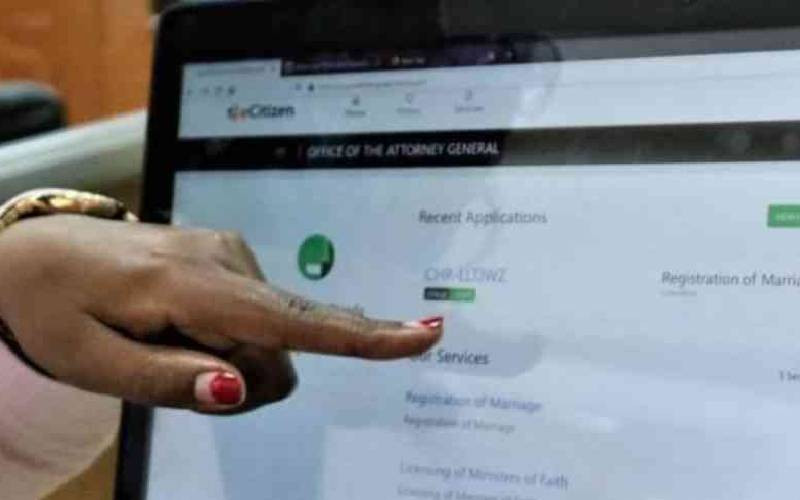 |
|
Otieno Baraza (left) is assisted by his teacher Kelvin Ngesa at an Adult Education Centre in Kiembeni, Mombasa, where he enrolled after his parents failed to raise money for his school fees at Nairobi School. [GIDEON MAUNDU/STANDARD] |
NAIROBI, KENYA: The Government is considering two secondary education financing options that have the potential of reducing parents' school fees burden.
This would however come with an additional average cost of Sh30 billion annually to the Government.
Under the first option, learning in day schools would be completely free if the State pays Sh23,975 per student.
The Government would meet all the costs for teaching, learning materials, related operational costs and lunch. But while education at day schools would be free under this option, boarding and special needs schools would charge Sh33,108 and Sh16,704 respectively, according to fees proposals presented to President Uhuru Kenyatta Wednesday.
With the current enrolment of 2.1 million secondary school students, the Government would be required to cough up a total of Sh51.5 billion. The current financial year has a budget allocation of Sh28 billion for fees. This means there is a deficit of Sh23.5 billion to implement this option.
Under the second option, parents would have to foot boarding costs including meals while the Government pays for teaching, learning materials and other related costs. Under this option, day schools would only charge a modest Sh5,861.
This however means that the Government will have to raise capitation per student to Sh18,112, according to the Report of the Task Force on Secondary School Fees 2014.
The team led by former assistant minister Kilemi Mwiria estimates that under this option, the cost of teaching and learning materials would be Sh4,792 annually. Another Sh13,320 is the estimated average cost of other operational costs per student. If implemented, boarding schools would charge Sh38,969 per year.
This option would cost the Government Sh10.8 billion to implement.
President Uhuru said the Ministry of Education and other relevant arms of government shall meet to consider the two options and prepare an implementation road map.
SANITARY TOWELS
The costs in the two scenarios would however go up "when other inputs" are factored. These include sanitary towels for needy girls, integration of Information and Communication Technology in secondary schools and capacity building for school managers.
The report by the 21-member team proposes several cost-cutting measures aimed at lowering the cost of secondary education.
The measures range from elimination of unnecessary levies, limiting the components of school uniform to essential elements and developing a uniform school meal policy for all schools within the same county.
Also proposed are development of effective staffing norms, constant maintenance of school facilities and adoption of cost-saving measures with regard to school utilities.
Stay informed. Subscribe to our newsletter
Overall, the team says the realistic unit cost for day schools is Sh11,105 and Sh38,969 for boarding schools. The new computed unit costs per item takes into account school type, costs of various inputs, per-capita spending, school activities and the overall school budget.
It also includes the annual government subsidy that has been raised to Sh12,870 from Sh10,265.
The report says special schools shall pay Sh22,830. The total school collection under the revised fees for one-stream schools shall be Sh4.3 million for day schools, Sh9.3 million for boarding schools and Sh9.9 million for special schools.
Two-stream schools shall collect Sh12.9 million while boarding schools under the same shall category collect Sh27.9 million.
On school uniforms, only essential elements should be part of the school dressing code, according to the report.
If adopted, the maximum cost of a school uniform would be Sh4,900, down from an average cost of Sh8,700 per student.
Currently, parents pay between Sh4,850 and Sh13,000 for uniform alone.
 The Standard Group Plc is a
multi-media organization with investments in media platforms spanning newspaper
print operations, television, radio broadcasting, digital and online services. The
Standard Group is recognized as a leading multi-media house in Kenya with a key
influence in matters of national and international interest.
The Standard Group Plc is a
multi-media organization with investments in media platforms spanning newspaper
print operations, television, radio broadcasting, digital and online services. The
Standard Group is recognized as a leading multi-media house in Kenya with a key
influence in matters of national and international interest.
 The Standard Group Plc is a
multi-media organization with investments in media platforms spanning newspaper
print operations, television, radio broadcasting, digital and online services. The
Standard Group is recognized as a leading multi-media house in Kenya with a key
influence in matters of national and international interest.
The Standard Group Plc is a
multi-media organization with investments in media platforms spanning newspaper
print operations, television, radio broadcasting, digital and online services. The
Standard Group is recognized as a leading multi-media house in Kenya with a key
influence in matters of national and international interest.










